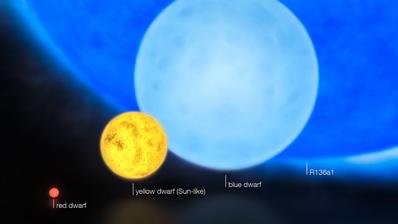



|

|

Giant star breaks all records
KEITH COOPER
ASTRONOMY NOW
Posted: 21 July 2010


A star that weighed in at over 320 times more massive than our Sun when it was born has been discovered deep within the Tarantula Nebula in the Large Magellanic Cloud, confounding expectations of just how big monster stars can be.
 Comparing the sizes of stars. From left: a red dwarf, a yellow ‘dwarf’ like the Sun, a blue ‘dwarf’, and R136a1. Image: ESO/M Kornmesser. Comparing the sizes of stars. From left: a red dwarf, a yellow ‘dwarf’ like the Sun, a blue ‘dwarf’, and R136a1. Image: ESO/M Kornmesser.
A group of astronomers led by the University of Sheffield’s Professor Paul Crowther used the European Southern Observatory’s Very Large Telescope in Chile, plus archive data from the Hubble Space Telescope, to measure up some of the largest stars in two young star clusters: one inside the star-forming region NGC 3603 that is 22,000 light years away in Southern Hemisphere skies, and RMC 136a in the Tarantula Nebula, which is 165,000 light years away and also in the Southern Hemisphere. For example, the components of one double star system in NGC 3603, collectively termed A1, have been measured as having 120 and 92 solar masses respectively (they had previously been measured at 114 and 84 solar masses by University of Montreal astronomers in 2007). These two giants orbit each other every 3.77 days, and according to models that describe the evolution of massive stars they are shedding mass at a rapid rate, having been born with masses of 148 and 106 times the mass of the Sun. But that is nothing compared to a star found in RMC 136a, designated R136a1, which has a mass of 265 solar masses and would have been over 320 solar masses when it was born a million or so years ago.
The reason massive stars lose mass is because they are inherently unstable. On the one hand, their huge mass is constantly trying to cause the star to collapse. On the other hand these stars produce so much energy that their radiation is trying to rip the star apart. Most stars are generally able to find a balance, but the most massive and luminous live life right on the edge. Above a given luminosity termed the Eddington Limit, the outpouring of radiation is so great that it would tear the star apart. It had been thought that the Eddington Limit is reached with stars around 150 solar masses, but these new observations more than double the potential mass.
 CZooming in on the cluster RMC 136a in the Tarantula Nebula. Image: ESO/P Crowther/C J Evans. CZooming in on the cluster RMC 136a in the Tarantula Nebula. Image: ESO/P Crowther/C J Evans.
“Because of their proximity to the Eddington Limit they lose mass at a pretty high rate,” Crowther tells Astronomy Now. He explains that, at birth, a 150 solar mass star is 40 percent of the way to the Eddington Limit, while a 300 solar mass star has a luminosity that is 55 percent of the Eddington Limit. As the stars age they grow more luminous (this holds even for lower mass stars such as the Sun, which was only two-thirds as luminous as it is today when it formed 4.6 billion years ago) and so to stave off the Eddington Limit the most massive stars have to shed mass into space under fierce stellar winds of radiation.
These giant stars have surface temperatures in excess of 40,000 degrees Celsius and are millions of times brighter than our Sun. On a Hertzsprung–Russell diagram that plots stellar luminosity against temperature (or colour), such massive stars would lie at the extreme upper left, on the tip of the main sequence of hydrogen-fusing stars and with exceptionally high luminosity. R136a1 has now overtaken the likes of eta Carinae and the Pistol Star as the most massive and luminous star in existence. If it were placed in our Solar System, it would outshine the Sun as much as the Sun outshines the Moon, and it produces 50 times more energy than all the young stars of the Orion Nebula put together. In fact, the four stars in RCM 136a that were born with masses greater than 150 solar masses produce half the radiation power of their cluster, which contains 100,000 stars in total.
Such monster stars only form in the densest, most violent star-forming regions and perhaps, speculates Crowther, they are the product of the merger of several protostars. However, he is confident that R136a1 is at the limit of how big stars can become. “Owing to the rarity of these monsters, I think it is unlikely that this new record will be broken any time soon,” admits Crowther. His team’s work can be found in the latest issue of Monthly Notices of the Royal Astronomical Society.
|

|

|

|
|



